Old Dominion Freight Line Bundle
How did Old Dominion Freight Line become a logistics giant?
From a single truck to a nationwide network, the story of Old Dominion Freight Line (ODFL) is a compelling narrative of growth and resilience in the freight transportation sector. Founded in 1934, this Old Dominion Freight Line SWOT Analysis reveals the key strategies that propelled it to the forefront of the trucking industry. Discover how ODFL navigated challenges and capitalized on opportunities to become a leading logistics provider.
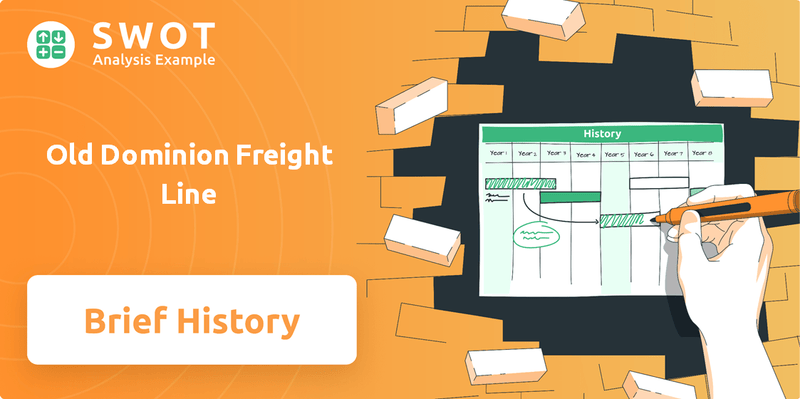
The journey of Old Dominion Freight Line, from its humble beginnings to its current stature, offers valuable insights into the evolution of the shipping company and the broader logistics landscape. Understanding the ODFL history provides a crucial context for analyzing its competitive advantages and strategic decisions. This brief history of Old Dominion Freight Line will delve into its founding and early years, exploring the pivotal moments that shaped its trajectory within the trucking industry and beyond.
What is the Old Dominion Freight Line Founding Story?
The story of Old Dominion Freight Line (ODFL) began in 1934, a testament to entrepreneurial spirit and family dedication. Founded by Earl Congdon Sr. and his wife, Lillian Congdon, the company emerged from humble beginnings in Richmond, Virginia. This marked the start of what would become a significant player in the freight transportation sector.
Earl Congdon Sr. took the wheel as the primary driver, while Lillian Congdon managed the business operations, even filling in as a driver when needed. Their initial focus was on transporting general commodities along a 94-mile route between Richmond and Norfolk, Virginia. This early model laid the groundwork for what would become a vast logistics provider.
The name 'Old Dominion' was chosen to reflect the Commonwealth of Virginia, where the company was founded. Lillian Congdon contributed $1,700, saved from her job as a telephone operator, to purchase the first truck, highlighting the bootstrapping nature of their early funding. This initial investment was crucial in launching the shipping company.
In 1935, a crucial moment arrived when Old Dominion received an operating certificate from the Interstate Commerce Commission (ICC). This allowed them to continue and expand operations along their established route, setting the stage for future growth in the trucking industry.
- The Congdon family's expertise and determination were central to identifying the opportunity in freight transportation.
- Lillian Congdon's initial investment of $1,700 from her savings was key.
- The ICC operating certificate in 1935 was a pivotal regulatory approval.
- The company's early focus was on transporting general commodities.
Old Dominion Freight Line SWOT Analysis
- Complete SWOT Breakdown
- Fully Customizable
- Editable in Excel & Word
- Professional Formatting
- Investor-Ready Format
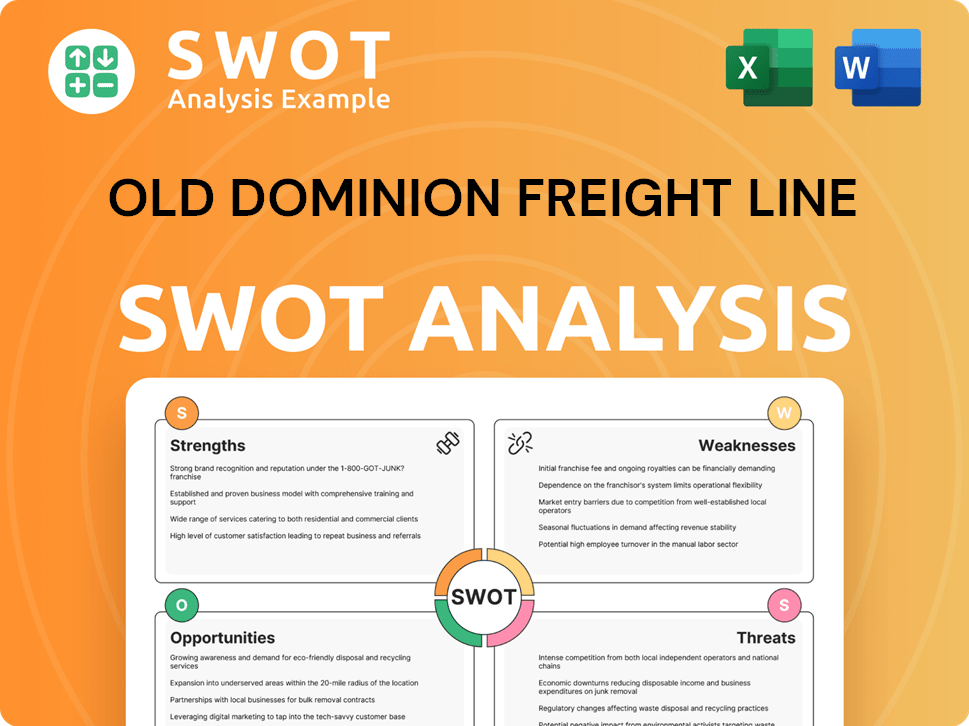
What Drove the Early Growth of Old Dominion Freight Line?
The early years of Old Dominion Freight Line, a key player in the freight transportation sector, were marked by consistent growth and strategic adjustments. From its humble beginnings in 1934, the company quickly expanded its operations and infrastructure. This early phase laid the groundwork for its future success in the competitive trucking industry.
Old Dominion Freight Line (ODFL) started operations in 1934, moving from the Congdons' home to a terminal outside a grocery store in 1935. By 1936, it had a facility with two truck bays. The company had three service centers and 45 employees by 1940. During World War II, the demand for transportation between Richmond and Norfolk surged, which helped the company grow.
Following Earl Congdon Sr.'s death in 1950, Lillian Congdon became president, with her sons joining the leadership. In 1957, ODFL expanded its operations to major markets in North Carolina and southern Virginia. The headquarters moved to High Point, North Carolina, in 1962, along with a merger with Bottoms-Fiske trucking company.
The 1960s and 1970s saw Old Dominion Freight Line expand through acquisitions, including Barnes Truck Line and Nilson Motor Express. The acquisition of Deaton Trucking in 1979 marked its entry into full-load and flat-bed trucking. The Motor Carrier Act of 1980 deregulated the trucking industry, allowing ODFL to expand services.
In 1991, Old Dominion Freight Line went public via an initial public offering (IPO), fueling further growth and technology investments. By 1995, additional acquisitions expanded its presence in the Southwest. This strategic approach, combined with a focus on service quality, shaped its trajectory as a major national LTL carrier. By 2024, the company had over 250 service centers.
Old Dominion Freight Line PESTLE Analysis
- Covers All 6 PESTLE Categories
- No Research Needed – Save Hours of Work
- Built by Experts, Trusted by Consultants
- Instant Download, Ready to Use
- 100% Editable, Fully Customizable
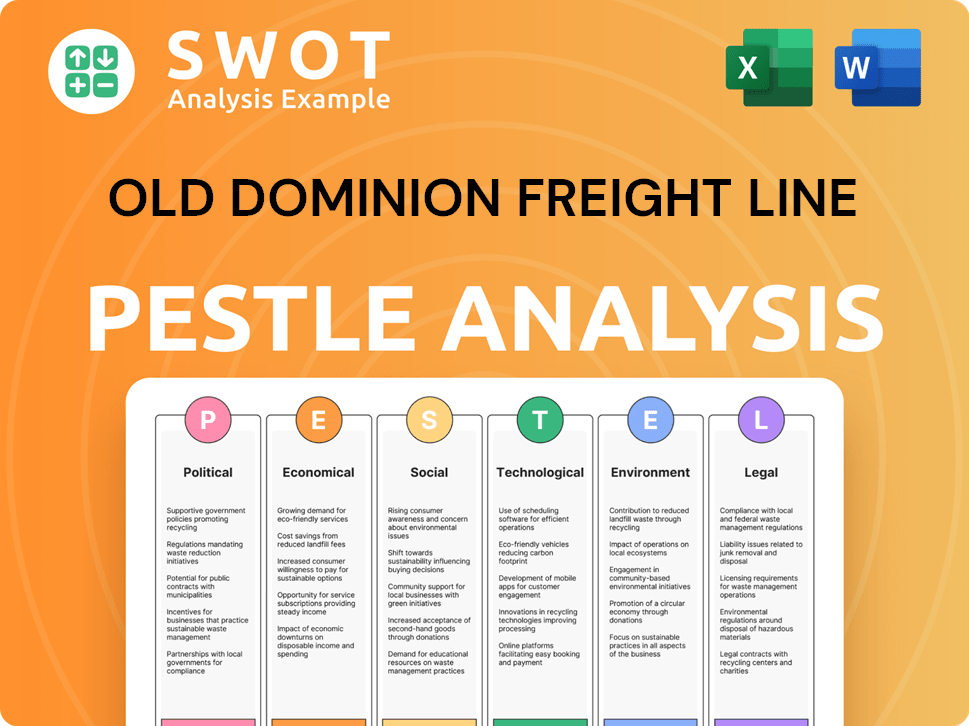
What are the key Milestones in Old Dominion Freight Line history?
The journey of Old Dominion Freight Line (ODFL) in the freight transportation sector is marked by significant achievements and pivotal moments that have shaped its trajectory. From its early days to its current position as a leading shipping company, the company has navigated various challenges and seized opportunities to establish itself in the trucking industry.
| Year | Milestone |
|---|---|
| 1934 | Founded in Richmond, Virginia, as a small trucking operation. |
| 1991 | Initial Public Offering (IPO), marking a significant step in its growth. |
| 1999 | Launched international LTL service into Mexico. |
| 2002 | Introduced Air Express Service, expanding service offerings. |
| 2022 | Over 99% of deliveries arrived on time, showcasing exceptional reliability. |
| 2024 | A shareholder proposal for science-aligned emissions reduction targets was made. |
Old Dominion Freight Line has consistently embraced innovation, particularly in its operational model. A key strategy involved adopting a network-based LTL model early on, which allowed for efficient consolidation and distribution across multiple service centers.
This model enabled the company to consolidate smaller shipments, improving efficiency and distribution across its service centers. This strategic focus on LTL became more pronounced after its IPO in 1991.
The company has consistently invested in modernizing its fleet and facilities, with technology playing a central role. This includes freight tracking, route optimization, and dock management.
Old Dominion Freight Line has been recognized as the #1 National LTL Carrier for Quality by Mastio & Company for 15 consecutive years. This recognition underscores its commitment to high service standards.
The company expanded its service offerings by initiating international LTL service into Mexico in 1999 and Air Express Service in 2002. This diversification helped to meet evolving customer needs.
Despite its successes, ODFL history includes confronting various challenges. Economic downturns and competitive pressures within the trucking industry are ongoing issues. The LTL sector's competitive nature can create pricing pressures, impacting market share.
Early challenges included unsuccessful attempts by employees to unionize under the Teamsters Union in 1939 and a subsequent 10-week strike in 1946. These events shaped the company's labor relations.
In Q1 2025, the company experienced a 5.8% revenue decline year-over-year due to ongoing softness in the domestic economy. This highlights the impact of economic cycles on the business.
The highly competitive LTL industry can lead to pricing pressures and impact market share. The company must continuously adapt to maintain its position.
A notable challenge is the lack of a clear low-carbon strategy, raising concerns about long-term competitiveness. This is particularly relevant as customer demand for decarbonized supply chains grows.
In May 2025, the company experienced an 8.4% drop in tonnage volumes. This decline underscores the need for strategic adjustments.
The competitive nature of the LTL industry can lead to pricing pressures. The company must manage these pressures to maintain profitability and market share.
For further insights into the financial performance and ownership structure, you can explore Owners & Shareholders of Old Dominion Freight Line.
Old Dominion Freight Line Business Model Canvas
- Complete 9-Block Business Model Canvas
- Effortlessly Communicate Your Business Strategy
- Investor-Ready BMC Format
- 100% Editable and Customizable
- Clear and Structured Layout
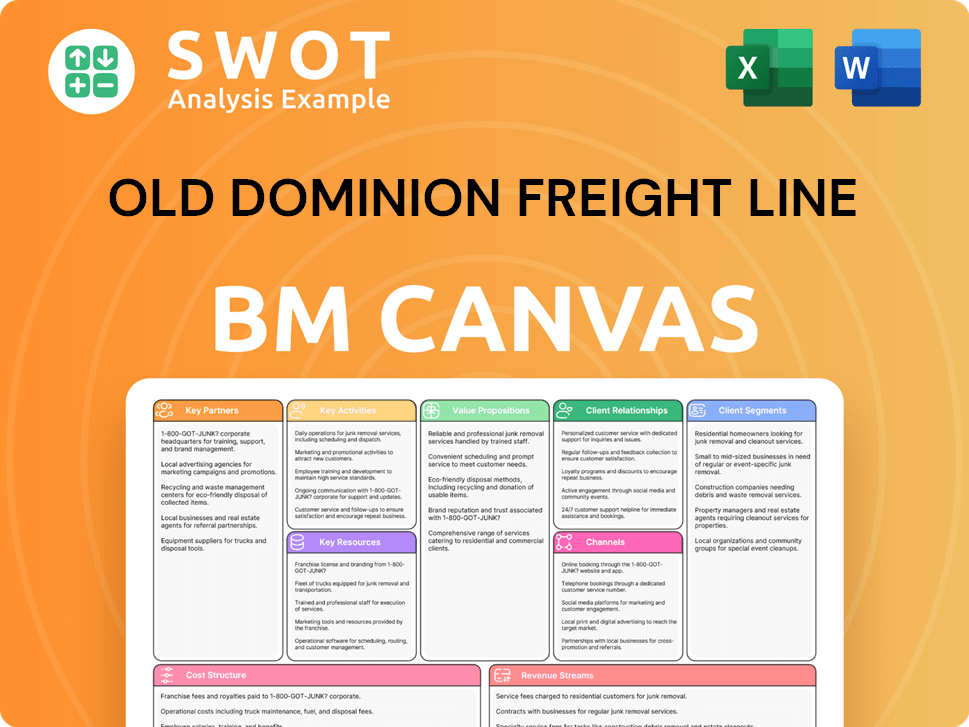
What is the Timeline of Key Events for Old Dominion Freight Line?
Here's a look at the major milestones in the history of Old Dominion Freight Line, a leading freight transportation company.
| Year | Key Event |
|---|---|
| 1934 | Founded as a small trucking company in Richmond, Virginia, by Earl and Lillian Congdon. |
| 1930s-1950s | Expanded its operations, primarily focusing on less-than-truckload (LTL) services in the Southeast. |
| 1960s-1970s | Grew through acquisitions and expanded its service area, becoming a regional player in the trucking industry. |
| 1990s | Focused on improving service quality and expanding its network, which led to significant growth and market share gains. |
| 2000s | Continued expansion and investment in technology, with a focus on providing superior customer service and operational efficiency. The company went public in 1991. |
| 2020s | Maintained its position as a leading LTL carrier, focusing on sustainability and technological advancements. |
Old Dominion Freight Line (ODFL) is expected to keep expanding its service network. This includes opening new service centers to improve its coverage and service capabilities. The company's strategic investments in real estate and equipment will likely continue to support its growth in the trucking industry.
ODFL will likely continue to invest in technology to improve operational efficiency. This includes implementing advanced tracking systems, optimizing route planning, and enhancing customer service platforms. Technological upgrades are key to maintaining a competitive edge in the logistics provider market.
The trucking industry faces challenges like driver shortages and rising fuel costs. ODFL's success depends on how it manages these factors. The company's ability to adapt to changing market conditions will be crucial. They are likely to focus on maintaining a strong customer base.
ODFL's financial performance has been strong, with consistent revenue growth and profitability. The company's ability to maintain its financial health will be important. Investors will continue to watch ODFL's financial metrics closely. In 2024, the company reported revenue of over $6 billion in the first quarter.
Old Dominion Freight Line Porter's Five Forces Analysis
- Covers All 5 Competitive Forces in Detail
- Structured for Consultants, Students, and Founders
- 100% Editable in Microsoft Word & Excel
- Instant Digital Download – Use Immediately
- Compatible with Mac & PC – Fully Unlocked
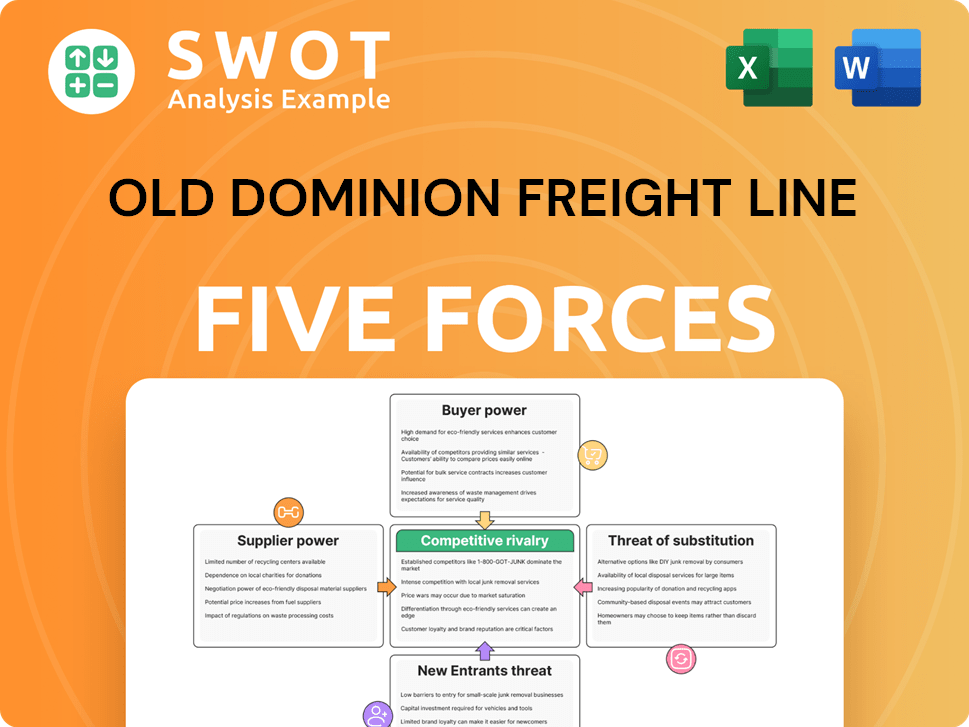
Related Blogs
- What is Competitive Landscape of Old Dominion Freight Line Company?
- What is Growth Strategy and Future Prospects of Old Dominion Freight Line Company?
- How Does Old Dominion Freight Line Company Work?
- What is Sales and Marketing Strategy of Old Dominion Freight Line Company?
- What is Brief History of Old Dominion Freight Line Company?
- Who Owns Old Dominion Freight Line Company?
- What is Customer Demographics and Target Market of Old Dominion Freight Line Company?
Disclaimer
All information, articles, and product details provided on this website are for general informational and educational purposes only. We do not claim any ownership over, nor do we intend to infringe upon, any trademarks, copyrights, logos, brand names, or other intellectual property mentioned or depicted on this site. Such intellectual property remains the property of its respective owners, and any references here are made solely for identification or informational purposes, without implying any affiliation, endorsement, or partnership.
We make no representations or warranties, express or implied, regarding the accuracy, completeness, or suitability of any content or products presented. Nothing on this website should be construed as legal, tax, investment, financial, medical, or other professional advice. In addition, no part of this site—including articles or product references—constitutes a solicitation, recommendation, endorsement, advertisement, or offer to buy or sell any securities, franchises, or other financial instruments, particularly in jurisdictions where such activity would be unlawful.
All content is of a general nature and may not address the specific circumstances of any individual or entity. It is not a substitute for professional advice or services. Any actions you take based on the information provided here are strictly at your own risk. You accept full responsibility for any decisions or outcomes arising from your use of this website and agree to release us from any liability in connection with your use of, or reliance upon, the content or products found herein.